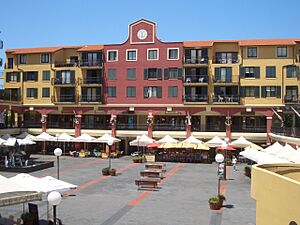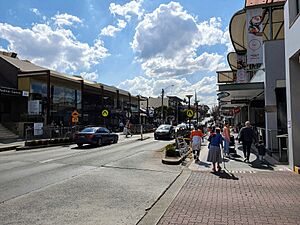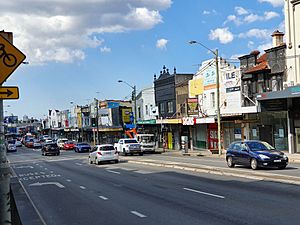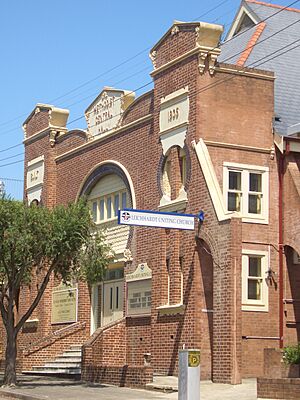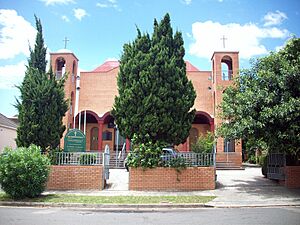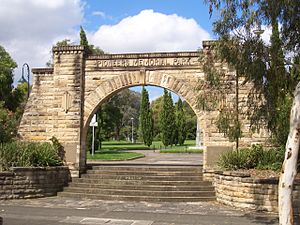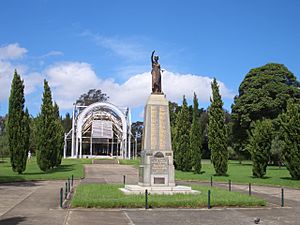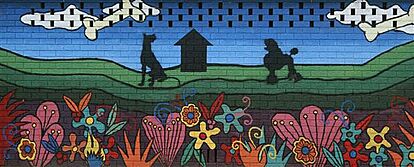Leichhardt, New South Wales facts for kids
Quick facts for kids LeichhardtSydney, New South Wales |
|||||||||||||||
|---|---|---|---|---|---|---|---|---|---|---|---|---|---|---|---|
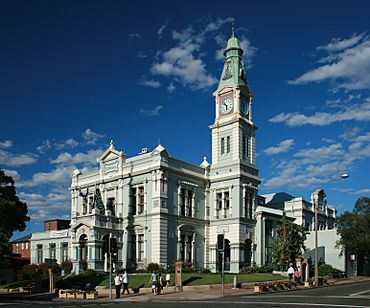
Leichhardt Town Hall
|
|||||||||||||||
| Established | 1846 | ||||||||||||||
| Postcode(s) | 2040 | ||||||||||||||
| Elevation | 40 m (131 ft) | ||||||||||||||
| Area | 4.565 km2 (1.8 sq mi) | ||||||||||||||
| Location | 5 km (3 mi) west of Sydney CBD | ||||||||||||||
| LGA(s) | Inner West Council | ||||||||||||||
| State electorate(s) | Balmain | ||||||||||||||
| Federal Division(s) | Grayndler | ||||||||||||||
|
|||||||||||||||
Leichhardt is a lively suburb in the Inner West of Sydney, New South Wales, Australia. It's located about 5 kilometres west of the main city centre, known as the Sydney central business district (CBD). Leichhardt is also the main office area for the Inner West Council, which is like its local government. The suburb is surrounded by other suburbs like Haberfield, Annandale, Lilyfield, Petersham, Lewisham, and Stanmore.
Contents
History of Leichhardt
First People of Leichhardt
Long ago, the area now called Leichhardt was home to the Wangal band. They were part of the Dharug language group, also known as the Eora people. The word 'Eora' means 'from this place'. It was used by local Aboriginal people to tell Europeans where they came from.
The Wangal people's land, called 'wanne', stretched from Balmain and Birchgrove in the east to Silverwater and Auburn in the west. The Parramatta River formed its northern border. Other Dharug groups lived nearby, like the Cadigal to the east.
European Settlement and Growth
Leichhardt is named after Ludwig Leichhardt, a famous explorer from Prussia (now part of Germany). In the 1840s, he explored vast areas of Australia. He became well-known for his 4,800 km journey from southern Queensland to Port Essington. Sadly, in 1848, he disappeared while trying to cross Australia from Queensland to Western Australia.
Leichhardt officially became a municipality (a local governing area) in 1871. Over the years, its boundaries changed. In 1949, it joined with Annandale and Balmain. Later, in 2003, some parts like Glebe and Forest Lodge became part of the City of Sydney.
Shopping and Fun
The main shopping area in Leichhardt is Norton Street. Here you'll find many different shops, including restaurants (especially Italian ones), cafés, and bookstores. There are also hotels, a cinema called Palace Cinema, and two shopping centres.
The Italian Forum, just off Norton Street, is a special place. It's designed to look like a traditional Italian town square, called a piazza. It has a central area just for people walking, with outdoor and indoor restaurants. The Leichhardt Library is also here. Small shops and boutiques are on the level above, with apartments overlooking everything.
Norton Street is famous for its annual Italian Festa in October. This festival celebrates the area's Italian culture with food, gift stalls, and live entertainment.
Another big shopping centre is MarketPlace Leichhardt. It's located on the corner of Marion and Flood Streets. This centre has free parking and stores like Woolworths, Aldi, and Target, plus over 60 other shops. It first opened in 1975.
Getting Around Leichhardt
Leichhardt is easy to reach by car using main roads like Parramatta Road and Norton Street. The City West Link runs along the northern edge of Leichhardt. This is a major road that connects to the Anzac Bridge and the city centre.
Leichhardt has excellent bus services that connect to the city and other areas. The main bus depot is located on the corner of William and Derbyshire Street.
Here are some of the bus routes in Leichhardt:
- Route 437 goes from Five Dock to the City QVB.
- Routes 438X and 438N travel from Martin Place to Abbotsford.
- Route 440 goes from Bondi Junction to Rozelle.
- Route 445 travels from Balmain to Campsie station.
- Route 469 travels from Leichhardt to Glebe.
- Routes 480, 483, and 461X travel from the Domain or Railway Square to Strathfield station.
- Route 470 travels from Circular Quay to Lilyfield.
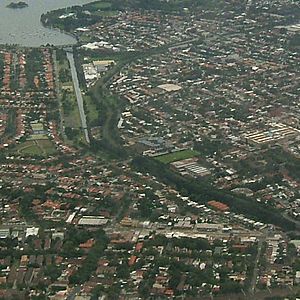
The southern part of Leichhardt is close to Petersham railway station, which is on the Inner West & Leppington Line. It's about an eight-minute walk from Norton Street.
The western and northern parts of Leichhardt are served by the Inner West Light Rail. There are light rail stops at Leichhardt North, Hawthorne, Marion, and Taverners Hill.
Leichhardt used to have trams from Sydney's old tram network from 1887 to the 1950s. The Annandale Line ran down Norton Street. The current bus depot was once a tram depot.
Homes in Leichhardt
Leichhardt is close to the city, making it a popular place to live. Because of its great location and many features, homes here are quite sought after and can be expensive. The houses in Leichhardt show a mix of styles, from older Victorian brick homes to newer houses and apartment buildings.
Churches and Schools
Leichhardt has several churches:
- All Souls Anglican Church
- Leichhardt Baptist Church
- Leichhardt Congregational Church
- Leichhardt Uniting Church
- St. Columba and The Holy Souls Parish (Catholic)
- St. Fiacre's Parish (Catholic)
- St. Joseph's Catholic Church
- The Parish of St. Gerasimos Church (Greek Orthodox)
Leichhardt also has a number of schools:
- Kegworth Public School: A primary school established in 1887.
- Leichhardt Public School: Another primary school, established in 1891.
- St. Columba's Primary School: A Catholic primary school, established in 1898.
- St. Fiacre's Primary School: A Catholic primary school, established in 1894.
- Sydney Secondary College Leichhardt Campus: A secondary school for years 7-10, established in 2002.
Important Landmarks
Here are some well-known landmarks in Leichhardt:
- Leichhardt Fire Station
- Leichhardt Hotel (an old building)
- Norton Hotel
- Old Cyclops Toy Factory
- Palace Cinema
Several buildings in Leichhardt are listed on the Register of the National Estate. This means they are important historical places:
- Leichhardt Town Hall (built in 1888)
- Post Office (built in 1888)
- Public School Buildings (first built in 1891)
- Church of England (built in 1883)
Parks and Fun Spots
Leichhardt has many parks and places for recreation:
- Pioneers Memorial Park: This park on Norton Street has large grassy areas, gardens, a war memorial, and a rotunda. It used to be the site of the Balmain Cemetery.
- War Memorial Park: Located on Moore and Catherine Streets, it has open grass, shaded areas, and a children's playground.
- 36th Battalion Park: This park has grass, a barbecue, play equipment, and a half-size basketball court.
- Blackmore Oval: Used for Rugby league and Cricket, it's home to the Leichhardt Wanderers Junior Rugby League and Cricket club.
- Leichhardt Oval: This is the home ground for the NRL team Wests Tigers.
- Lambert Park (Leichhardt): Home to the NSW Premier League team APIA Leichhardt Tigers.
Culture and Community
Leichhardt is a hub for creative people and is known for its colourful and imaginative mural art. You can see murals at Renwick Lane and under the Hawthorne Canal Railway. The area also has many art galleries. Boomali Gallery, an Aboriginal Arts Organisation, is located in Flood Street.
The Italian community has a strong presence in Leichhardt. Many social and cultural groups are based here. Co.As.It. is one such group that helps the community and promotes the Italian language and culture in New South Wales. Leichhardt was once known as Sydney's 'Little Italy'. While it's become less distinctly Italian as more people move in, its Italian feel is still strong. You can especially feel it in the popular Italian restaurants and cafés on Norton Street.
Every year, Leichhardt hosts the Italian Festa on Norton Street. The street is closed to traffic and becomes a huge outdoor café. It celebrates Leichhardt's diverse culture with an International Food Fair, gift stalls, and live entertainment. Leichhardt is also famous for its many cafés. The oldest one is Café Sport, located on Norton Street.
Population Facts
| 2016 Census: Leichhardt | |||
|---|---|---|---|
| Leichhardt | Sydney | Australia | |
| Population | 14,625 | 4,321,535 | 23,401,892 |
| Median age | 36 | 35 | 38 |
| Median household income (weekly) | $2,256 | $1,802 | $1,438 |
| Born in Australia | 64.2% | 54.6% | 66.7% |
According to the 2016 census, there were 14,625 people living in Leichhardt.
- About 1.4% of the population were Aboriginal and Torres Strait Islander people.
- Most people (64.2%) were born in Australia. Other common birthplaces included England (5.0%) and Italy (3.2%).
- English was the main language spoken at home by 72.8% of residents. Italian was the next most common language (5.2%).
- When asked about religion, 41.1% said they had no religion, and 26.4% were Catholic.
In terms of homes, 41% were terraces, semis, or townhouses. About 35% were separate houses, and 22% were apartments. The average age of people in Leichhardt was 36, similar to the rest of Sydney. Many people were renting (40.1%) or paying off a home loan (34.2%). The average monthly home loan payment was $3,000, which is higher than the national average.
Since the mid-1900s, Leichhardt has been a hub for the Italian community. This is why you see many Italian-owned businesses. While it's not as strongly Italian as it once was, due to changes in the suburb, its Italian feel is still very noticeable, especially on Norton Street.
Famous People from Leichhardt
- Brian Blain (1936–1994), an actor.
- Vanessa Downing (born 1958), an actress.
- Thelma Forshaw (1923–1995), a writer and journalist who went to St Fiacre's Primary School.
- Aaron Woods (born 1991), a rugby league player.
Gallery


